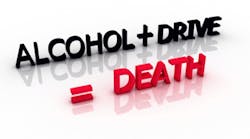The National Transportation Safety Board Seeks Lower Alcohol Limits, Finds Support from ASSE
In the past several decades, awareness of the dangers of alcohol-impaired driving has increased. However, alcohol-impaired driving still accounts for approximately one-third of all U.S. highway fatalities.
Public and private entities focusing on this safety issue have changed social perceptions concerning alcohol-impaired driving; they also have achieved important legislative actions to help reduce it. Due to these efforts, the number of lives lost annually in alcohol-impaired-driver-related crashes declined 53 percent, from 21,113 in 1982 to 9,878 in 2011; and the percentage of highway fatalities resulting from alcohol-involved crashes is down from 48 percent in 1982 to about 31 percent today.
According to the report, “Reaching Zero: Actions to Eliminate Alcohol-Impaired Driving,” released by the National Transportation Safety Board (NTSB) earlier this year, success in addressing this safety issue has plateaued in the United States. “Since 1995, although the annual number of fatalities has declined, nearly one in three of all highway deaths still involves an alcohol-impaired driver. The cause of these deaths is well understood and preventable, yet even the most concerted efforts have not kept thousands of lives from being lost,” noted the report authors.
If traditional methods are no longer reducing the problem, new – and possibly challenging – initiatives must be considered. In the report, the NTSB:
- Describes the scope of the impaired driving problem;
- Summarizes the efforts of advocacy groups, researchers, law enforcement agencies, traffic safety groups, public health organizations, legislators and motor vehicle agencies, as well as federal, state and local governments, to reduce the number of crashes, injuries and fatalities;
- Examines the effect of alcohol consumption on an individual’s ability to operate a motor vehicle and on the risk of being involved in a crash; and
- Evaluates the effectiveness of current and emerging alcohol-impaired driving countermeasures and identifies new approaches and actions needed to reduce and ultimately eliminate alcohol-impaired driving.
Specifically, the report makes recommendations to the states in the following safety issue areas:
- Reducing the per se blood alcohol concentration (BAC) limit for all drivers.
- Conducting high-visibility enforcement of impaired driving laws and incorporating passive alcohol sensing technology into enforcement efforts.
- Expanding the use of in-vehicle devices to prevent operation by an impaired driver.
- Using driving while intoxicated (DWI) courts and other programs to reduce recidivism by repeat DWI offenders.
- Establishing measurable goals for reducing impaired driving and tracking progress toward those goals.
On the federal side, the report recommends that the National Highway Traffic Safety Administration (NHTSA) support state efforts by seeking authority to award incentive grants to states for establishing per se BAC limits of 0.05 or lower and by establishing best practices for alcohol ignition interlock programs and creating incentives to encourage states to adopt the best practices. It also recommends that NHTSA develop and disseminate to states best practices for DWI courts.
Recently, the American Society of Safety Engineers announce that organization supports NTSB’s efforts encouraging states to reduce the legal standard of driver impairment due to alcohol consumption to 0.05 percent from 0.08 percent.
Writing on behalf of the organization’s 36,000 members, President Patricia M. Ennis, CSP, AMR, told Christopher A. Hart, acting chairman of NTSB: “ASSE’s interest in seeing that the legal standard for driver impairment is lowered arises from our members’ interest in doing whatever is reasonably possible to make driving safer. Year after year more workers die on our nation’s highways than any other kind of workplace…”
She noted that ASSE members know how to work with employers to manage the risks related to workers driving on the nation’s highways. “But,” she added, “they need the appropriate support of government and law enforcement to reduce the chance that, despite their best efforts, a worker will be the victim of the alcohol-impaired driving of another driver.”
The members of ASSE’s Transportation Practice Specialty released its own white paper that supported a lower BAC and other efforts, including increased education, in-vehicle devices and other measures addressed in NTSB’s “Reaching Zero.”

